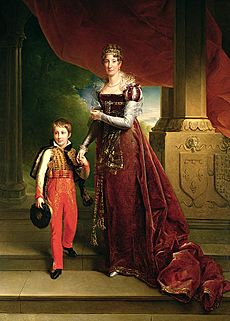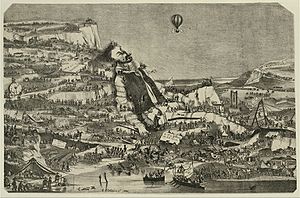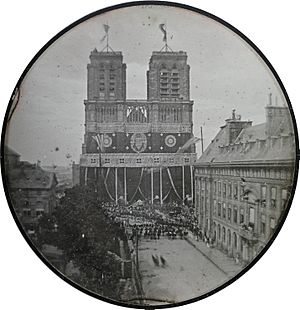Ferdinand Philippe, Duke of Orléans facts for kids
Quick facts for kids Ferdinand Philippe |
|||||
|---|---|---|---|---|---|
| Prince Royal of France Duke of Orléans |
|||||
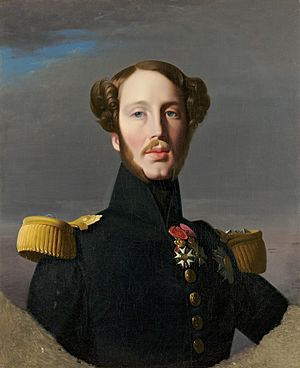
Portrait by Jean Auguste Dominique Ingres, c. 1843
|
|||||
| Born | 3 September 1810 Palermo, Kingdom of Sicily |
||||
| Died | 13 July 1842 (aged 31) Sablonville, Kingdom of France |
||||
| Burial | 16 July 1842 Chapelle royale de Dreux |
||||
| Spouse |
Duchess Helene of Mecklenburg-Schwerin
(m. 1837) |
||||
| Issue | |||||
|
|||||
| House | Orléans | ||||
| Father | Louis Philippe I, King of the French | ||||
| Mother | Maria Amalia of Naples and Sicily | ||||
| Religion | Roman Catholicism | ||||
| Signature | |||||
Ferdinand Philippe, Duke of Orléans (born Ferdinand Philippe Louis Charles Henri Joseph; 3 September 1810 – 13 July 1842) was the oldest son of Louis Philippe I, who became the King of France. His mother was Maria Amalia of Naples and Sicily.
Ferdinand Philippe was born in Sicily while his parents were living there in exile. From the moment he was born, he was the heir to the House of Orléans, a powerful royal family. When his father became the King of the French in 1830, Ferdinand Philippe became the Prince Royal of France and the Duke of Orléans. Sadly, he died in 1842, so he never became king. He also didn't live to see his family go into exile in the United Kingdom after his father's rule ended.
Contents
Early life and education
Ferdinand Philippe was born in Palermo in September 1810. At birth, he was given the title Duke of Chartres. His full name was Ferdinand Philippe Louis Charles Henri Joseph, named after his grandfathers, Ferdinand I of the Two Sicilies and Philippe Égalité. Even though he was born in exile, he was considered a "prince of the blood," meaning he was a close relative of the royal family. As the oldest son, he was the main heir to the title of Duke of Orléans.
The young prince first visited France in 1814 and then moved there permanently in 1817. In 1819, his father wanted him to have a modern education. So, Ferdinand Philippe went to the Collège Henri-IV and studied alongside other students, just like a regular person. He did very well in his studies and even took classes at the École Polytechnique, a famous engineering school.
After a trip to Great Britain in 1819, he joined the military. In 1824, King Charles X made him a colonel in the 1st Hussar Regiment. In September 1824, King Charles X also gave him the special title "Royal Highness." Ferdinand Philippe kept this title when his father became king six years later.
July Revolution and public service
In 1830, a big event called the July Revolution happened in France. At that time, the young Duke of Chartres was serving in the army in Joigny. He quickly showed his support for the revolution by making his soldiers wear the cockade of France, a special ribbon that showed loyalty to France. He then led his troops to help the uprising in Paris.
On August 3, he entered Paris at the head of his regiment. When his father was offered the French throne, Prince Ferdinand Philippe became the Duke of Orléans and the Prince Royal, meaning he was next in line to the throne. He joined the King's Council, where he often spoke his mind and pushed for changes that would help the revolutionary youth.
In November 1831, the Duke of Orléans and Marshal Nicolas Soult were sent to stop the Canut revolts in Lyon. He handled this difficult job without violence and quickly calmed the situation. He even became quite popular. During a serious cholera outbreak in 1831, he bravely visited sick patients at the Hôtel-Dieu de Paris hospital, even though it was dangerous. People saw him as a kind prince who cared about the poor. He became a symbol of hope for those who wanted France to be more democratic while still having a king.
Military achievements
Ferdinand Philippe had a successful military career. In 1831, he went on his first military campaign in Belgium with his younger brother, Prince Louis, Duke of Nemours. They were excited to visit the battlefield of Jemmapes, where their father had fought in 1792. The next year, Ferdinand Philippe returned to Belgium, leading a group of soldiers. He showed great bravery during the attack on the Saint-Laurent Lunette, inspiring his soldiers.
In 1835, he asked his father for permission to go to Algeria to fight against Emir Abdelkader. He was wounded in the Battle of Habrah and helped capture Mascara and Tlemcen. When he returned to Paris, he was seen as a military hero. He went back to Algeria in 1839 to help France take control of the country's interior. This led to more conflict and eventually France fully occupying Algeria. He went to Algeria a third time in 1840, bringing his younger brother, the Duke of Aumale, to teach him about military life.
Ferdinand Philippe's military success made him very popular. He also cared deeply about his soldiers. He worked to improve their living conditions and morale. He helped create new military units and even started writing histories of the regiments he had commanded.
Marriage and family life
Finding a wife for Ferdinand Philippe was a very important political matter for the July Monarchy. The King wanted his son to marry someone who could help France make new alliances with other European countries. Many different princesses were considered from various royal families across Europe.
After many discussions, the choice finally fell on Helene Luise Elisabeth of Mecklenburg-Schwerin (1814–1858). She was the niece of King Friedrich Wilhelm III of Prussia. Even though there were some difficulties, the marriage was arranged.
The wedding took place on 30 May 1837 at the Château de Fontainebleau. The Archbishop of Paris did not allow the wedding to be held at Notre Dame de Paris because of religious differences (Helene was Protestant). So, there were two ceremonies: a civil one and two religious ones (Catholic and Lutheran).
The marriage was very happy. Ferdinand Philippe and Helene had two children:
- Prince Philippe, Count of Paris (1838–1894), who became the Prince Royal.
- Prince Robert, Duke of Chartres (1840–1910).
Supporter of the arts
Ferdinand Philippe loved books, music, and art. He enjoyed collecting beautiful objects and spent a lot of money each year on art or supporting artists. In his apartments at the Palais des Tuileries, he collected old medieval and Renaissance items, ceramics, Chinese and Japanese porcelain, and fancy furniture.
He was very interested in modern painters. He bought paintings from artists like Ary Scheffer and Newton Fielding, who had taught him landscape painting. He also owned works by famous artists such as Eugène Delacroix, Alexandre-Gabriel Decamps, and Paul Delaroche. He especially liked landscapes by painters from the Barbizon school, like Camille Corot. He even asked Jean-Auguste-Dominique Ingres to paint his portrait.
Ferdinand Philippe was also a talented artist himself. He made etchings and lithographs. One of his lithographs was a funny picture showing a sleeping Gulliver surrounded by tiny people, making fun of a serious warning from the government.
Death and legacy
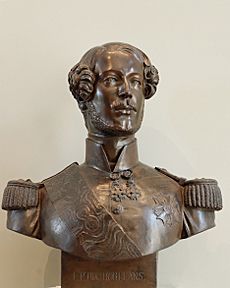
In 1842, the Duke was planning to go to Saint-Omer to inspect part of the army he commanded. On 13 July 1842, he was traveling from the Tuileries Palace to Neuilly-sur-Seine to say goodbye to his family. He chose to ride in an open carriage.
Tragically, the horses pulling his carriage lost control in Sablonville. Ferdinand Philippe fell out of the carriage and fractured his skull. Despite the best efforts of his doctors, the 31-year-old Duke died a few hours later, surrounded by his family. The poet Alfred de Musset wrote a poem about this sad accident.
Ferdinand Philippe's funeral was held at Notre Dame Cathedral in Paris. He was buried in a beautiful tomb at the Chapelle Royale in Dreux.
After his death, his father, King Louis Philippe, lost a lot of public support. Six years later, the King and his family were forced to leave France and go into exile in Great Britain. Ferdinand Philippe's widow, Princess Helene, died nearly 16 years after him in England. Because Helene was Protestant, she could not be buried in the Catholic chapel with her husband. So, a special room was built next to the chapel with a separate entrance. A window was made between her tomb and her husband's, and her sculpture shows her reaching through it towards him.
Children
- Prince Philippe, Count of Paris (1838–1894), who was the Prince Royal. He married Princess Marie Isabelle of Orléans and had children.
- Prince Robert, Duke of Chartres (1840–1910). He married Princess Françoise of Orléans and had children.
Honours and awards
 Kingdom of France: Knight of the Holy Spirit, 30 May 1825
Kingdom of France: Knight of the Holy Spirit, 30 May 1825 Belgium: Grand Cordon of the Order of Leopold, 10 March 1833
Belgium: Grand Cordon of the Order of Leopold, 10 March 1833 Two Sicilies:
Two Sicilies:
- Knight of St. Januarius
- Grand Cross of St. Ferdinand and Merit
 Spain: Knight of the Golden Fleece, 1 July 1837
Spain: Knight of the Golden Fleece, 1 July 1837 Kingdom of Portugal: Grand Cross of the Tower and Sword
Kingdom of Portugal: Grand Cross of the Tower and Sword
In fiction
- Ferdinand-Philippe was a character in the story "Die Herzen der Könige" (The Hearts of the Kings) by Hanns Heinz Ewers.
Sources
- Guy Antonetti, Louis-Philippe, Paris, Librairie Arthème Fayard, 2002 ISBN: 2-213-59222-5
- Mullié, Charles (1852). "Orléans (Ferdinand-Philippe-Louis-Charles-Henri-Joseph) de Bourbon, duc d'". Biographie des célébrités militaires des armées de terre et de mer de 1789 à 1850. Paris: Poignavant et Compagnie.
- Ferdinand-Philippe d'Orléans, duc d'Orléans, Souvenirs 1810–1830, texte établi, annoté et présenté par Hervé Robert, Genève, Librairie Droz S.A., 1993
- Ferdinand-Philippe d'Orléans, duc d'Orléans, Lettres 1825–1842, publiées par ses fils le comte de Paris et le duc de Chartres, Paris, Calmann-Lévy, 1889
|
Ferdinand Philippe, Duke of Orléans
Cadet branch of the House of Bourbon
Born: 3 September 1810 Died: 13 July 1842 |
||
| French royalty | ||
|---|---|---|
| Preceded by Louis Philippe later became King Louis Philippe I |
Heir to the Throne as Heir apparent 9 August 1830 – 13 July 1842 |
Succeeded by Prince Philippe, Count of Paris |
| Preceded by Louis Philippe later became King Louis Philippe I |
Duke of Orléans 9 August 1830 – 13 July 1842 |
Vacant
Title next held by
Prince Philippe |
See also
 In Spanish: Fernando Felipe de Orleans para niños
In Spanish: Fernando Felipe de Orleans para niños


